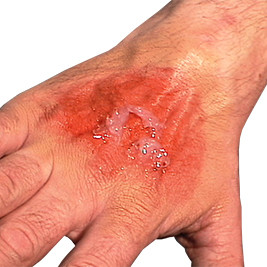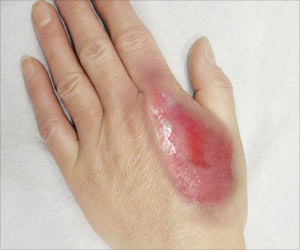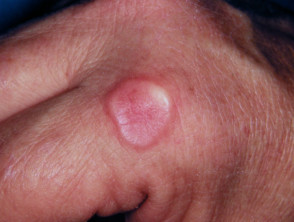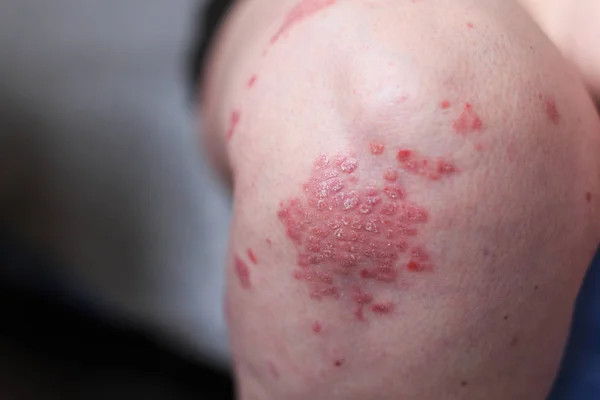Definition
Chemical injuries, particularly chemical burns, result from contact between the skin or eyes and irritating substances, such as acidic (pH <7) or alkaline (pH >7) chemicals. When these substances make contact with the skin or eyes, they trigger a chemical reaction in the affected area, causing injury.
Burns caused by chemicals can be a short-term health problem, or appear over a long period if not treated immediately. Burns can also occur in internal organs if the chemical is accidentally swallowed. Death can occur if someone swallows chemicals in an attempt to commit suicide. If you see someone exposed to or swallowing chemicals, you should immediately take the person to be examined at the nearest health facility.
Causes
Chemical burns typically occur from contact with acidic or alkaline substances. This can be found in various settings where such chemicals are utilized or present, such as schools, workplaces, or others. Several common products are known to induce chemical burns, including:
- Acidic substances found in car batteries
- Laundry bleach
- Ammonia-based compounds
- Vehicle cleaning agents
- Teeth whitening products
- Chlorine-based products used in swimming pools
- Hair coloring products
- Metals
Risk factor
Certain populations have the potential to be at increased risk of experiencing burns due to chemicals, for example:
- Baby
- Older adults
- People with disabilities
The above age group tends not to be able to use or control the use of chemical substances well. You may also be at risk of getting burns from acidic or alkaline chemicals if you are using chemicals without an assistant or assistance, and have a medical condition that limits body movement.
Symptoms
Chemical burns can have different symptoms depending on how exposure occurs. Burns from ingesting chemicals differ from those caused by skin contact. Factors like the location of contact, severity, and how the burns appear can vary due to several factors, including:
- Duration of skin exposure to the chemical substances
- Method of exposure, if the substance is inhaled or ingested
- Presence of open wounds on the skin during chemical exposure
- Quantity and potency of the chemical substance involved
- The classification of the substance (gas, liquid, solid substance)
- The nature of the chemical (acidic or alkaline substance)
Ingestion of alkaline chemicals can lead to stomach burns. Common symptoms associated with chemical burns are:
- Darkened or necrotic skin, particularly evident in burns induced by acidic substances
- Irritation
- Erythema
- The sensation of burning in affected areas of the body
- Numbness or pain
- Visual impairments in cases of chemical contact with the eyes
Symptoms associated with ingesting these chemicals may include:
- Arrhythmia
- Headaches
- Low blood pressure
- Heart attack or cardiac arrest
- Dyspnea
- Coughing
- Seizures
- Vertigo
- Muscle rigidity and spasms
Diagnosis
Diagnosing chemical burns involves a systematic approach, the doctor will start interviewing patients about their symptoms and medical history, followed by a physical examination, and diagnostic tests if required. Doctors base their diagnosis on various factors, including:
- Severity of pain in the affected area
- Extent of tissue damage
- Depth of the wound
- Indications of potential infection
- Degree of swelling accompanying the injury
Subsequently, burns are categorized according to their depth. First-degree burns are confined to the outermost layer of the skin (epidermis). Second-degree burns are burns that extend into deeper skin layers (dermis). Burns reaching the third layer of skin (subcutaneous layer) are classified as third-degree burns.
Management
The initial step in treating chemical burns involves promptly removing or cleaning the chemical substances that have come into contact with the body. Subsequently, the affected area has to be rinsed with running water for 10-20 minutes. In cases of chemical burns to the eyes, flush the eyes with running water for at least 20 minutes before seeking medical attention at the nearest healthcare facility.
Cleanse any contaminated clothing or jewelry. For existing burns, cover the injury with dry sterile dressings or clean cloth if available. In instances of first-degree burns confined to the superficial skin layer, pain relief medications such as paracetamol can be taken after rinsing the affected area if the patient still experiences pain.
Urgent medical treatment is warranted for severe burns or if symptoms impact organ function, such as visual impairments.
Complications
The potential complications of burns correlate with the extent of the injury. Typically, mild burns tend to heal more quickly if the patients are given proper treatment. However, severe burns often necessitate longer treatment.
Complications associated with severe burns may include:
- Alterations in body shape attributable to burns
- Limb loss
- Infection
- Formation of severe scarring
- Muscular and tissue damage
- Psychological symptoms
With comprehensive treatment and rehabilitation, individuals afflicted with severe chemical burns can experience improvement in their condition.
Prevention
There are several steps you can take to help prevent chemical burns. These are the measures:
- Store chemical substances out of children's reach and away from food and beverages
- Ensure the chemical substances are stored properly after use
- Chemical substances should be used in well-ventilated areas
- Minimize chemical usage whenever feasible
- Purchase chemicals in secure containers
- Wear protective clothing or gloves to shield the body from chemical exposure
When to see a doctor?
If you experience symptoms that do not go away and occur continuously, or worsening complaints such as:
- Persistent shortness of breath or difficulty breathing
- Seizures or loss of consciousness
- Burns exceeding 8 cm in size
- Burns located on the face, hands, feet, or major joints such as the knees
- Severe, unrelenting pain unresponsive to pain relief medications
- Low blood pressure
A comprehensive assessment by a medical professional such as a surgeon or dermatologist typically involves a thorough medical history review, physical examination, and supporting diagnostic tests to ascertain an accurate diagnosis and prescribe suitable treatment.
Looking for more information about other diseases? Click here!
- dr Hanifa Rahma
VanHoy TB, Metheny H, Patel BC. Chemical Burns. [Updated 2022 May 1]. In: StatPearls [Internet]. Treasure Island (FL): StatPearls Publishing; 2022 Jan-. Available from: https://www.ncbi.nlm.nih.gov/books/NBK499888/
Medline Plus. Chemical burn or reaction. September 2019. Available from: https://medlineplus.gov/ency/article/000059.htm
Healthline. Chemical burns. February 2020. Available from: https://www.healthline.com/health/chemical-burn-or-reaction#












